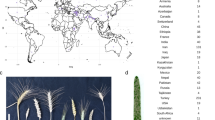Abstract
The first genetic linkage map of macadamia (Macadamia integrifolia and M. tetraphylla) is presented. The map is based on 56 F1 progeny of cultivars ‘Keauhou’ and ‘A16’. Eighty-four percent of the 382 markers analysed segregated as Mendelian loci. The two-way pseudo-testcross mapping strategy allowed construction of separate parental cultivar maps. Ninety bridging loci enabled merging of these maps to produce a detailed genetic map of macadamia, 1100 cm in length and spanning 70–80% of the genome. The combined map comprised 24 linkage groups with 265 framework markers: 259 markers from randomly amplified DNA fingerprinting (RAF), five random amplified polymorphic DNA (RAPD), and one sequence-tagged microsatellite site (STMS). The RAF marker system unexpectedly revealed 16 codominant markers, one of them a putative microsatellite locus and exhibiting four distinct alleles in the cross. This molecular study is the most comprehensive examination to date of genetic loci of macadamia, and is a major step towards developing marker-assisted selection for this crop.
Similar content being viewed by others
References
Aradhya, M.K., L.K. Yee, F.T. Zee & R.M. Manshardt, 1998. Genetic variability in Macadamia. Genet Res Crop Ev 44: 1-14.
Beckmann, J.S. & M. Soller, 1990. Towards a unified approach to the genetic mapping of eukaryotes based on sequence-tagged microsatellite sites. Bio/Technology 8: 930-932.
Caetano-Anollés, G., B.J. Bassam & P.M. Gresshoff, 1991. DNA amplification fingerprinting using very short arbitrary oligonucleotide primers. Bio/Technology 9: 553-557.
Conner, P.J., S.K. Brown & N.F. Weeden, 1998. Molecular-marker analysis of quantitative traits for growth and development in juvenile apple trees. Theor Appl Genet 96: 1027-1035.
Crouzillat, D., E. Lerceteau, V. Petiard, J. Morera, H. Rodriguez, D. Walker, W. Phillips, C. Ronning, R. Schnell, J. Osei & P. Fritz, 1996. Theobroma cacao L.: a genetic linkage map and quantitative trait loci analysis. Theor Appl Genet 93: 205-214.
Echt, C.S. & C.D. Nelson, 1997. Linkage mapping and genome length in eastern white pine (Pinus strobus L.). Theor Appl Genet 94: 1031-1037.
Grattapaglia, D. & R. Sederoff, 1994. Genetic linkage maps of Eucalyptus grandis and Eucalyptus urophylla using a pseudo-testcross mapping strategy and RAPD markers. Genetics 137: 1121-1137.
Hamilton, R.A. & P.J. Ito, 1976. Development of macadamia nut cultivars in Hawaii. Calif Macadamia Soc Yrbk 22: 94-100.
Hemmat, M., N.F. Weeden, A.G. Manganaris & D.M. Lawson, 1994. Molecular marker linkage map for apple. J Hered 85: 4-11.
Hulbert, S.H., T.W. Ilott, E.J. Legg, S.E. Lincoln, E.S. Lander & R.W. Michelmore, 1988. Genetic analysis of the fungus Bremia lactucae, using restriction fragment length polymorphisms. Genetics 120: 947-958.
Marques, C.M., J.A. Aradjo, J.G. Ferreira, R. Whetten, D.M. O'Malley, B.-H. Liu & R. Sederoff, 1998. AFLP genetic maps of Eucalyptus globulus and E. tereticornis. Theor Appl Genet 96: 727-737.
McConchie, C.A., N.M. Meyers, V. Vithanage & C.G.N. Turnbull, 1997. Pollen Parent Effects on Nut Quality and Yield in Macadamia-Final Report Project MC 302. Horticultural Research and Development Corporation, p. 19. HRDC, Australia.
Meyers, N., 1997. Pollen Parent Effects on Macadamia Yield. PhD dissertation. University of Queensland, Australia.
Olson, M., L. Hood, C. Cantor & D. Botstein, 1989. A common language for physical mapping of the human genome. Science 245: 1434-1435.
Paglia, G. & M. Morgante, 1998. PCR-based multiplex DNA fingerprinting techniques for the analysis of conifer genomes. Mol Breeding 4: 173-177.
Paterson, A.H., S.D. Tanksley & M.E. Sorrels, 1991. DNA markers in plant improvement. Adv Agron 46: 39-90.
Pooler, M.R. & R. Scorza, 1995. Aberrant transmission of RAPD markers in haploids, doubled haploids, and F1 hybrids of peach: observations and speculations on causes. Scientia Horticult 64: 233-241.
Powell, W., G.C. Machray & J. Provan, 1996a. Polymorphism revealed by simple sequence repeats. Trends Plant Sci 1: 215-222.
Powell, W., M. Morgante, C. Andre, M. Hanafey, J. Vogel, S. Tingey & A. Rafalski, 1996b. Comparison of RFLP, RAPD, AFLP, and SSR (microsatellite) markers for germplasm improvement. Mol Breeding 2: 225-238.
Sedgley, M., F.D.H. Bell, D. Bell, C.W. Winks, S.J. Pattison & T.W. Hancock, 1990. Self-and cross compatibility of macadamia cultivars. J Hortic Sci 65: 205-218.
Stace, H.M., A.W. Douglas & J.F. Sampson, 1998. Did ‘paleopolyploidy’ really occur in Proteaceae? Aus Sys Bot 11: 613-629.
Stam, P. & J.W. van Ooijen, 1995. JoinMapTM version 2.0: Software for the Calculation of Genetic Linkage Maps. CPRO-DLO, Wageningen.
Thomas, M.R., S. Matsumoto, P. Cain & N.S. Scott, 1993. Repetitive DNA of grapevine: classes present and sequences suitable for cultivar identification. Theor Appl Genet 86: 173-180.
Vithanage, V. & C.W. Winks, 1992. Isozymes as genetics for Macadamia. Scientia Horticult 49: 103-115.
Vithanage, V., K.L Anderson, C.P. Peace & M.R. Thomas, 2002. Sequence Tagged Microsatellite Site and Random Amplified Polymorphic DNA marker polymorphism in macadamia. Theor Appl Genet (submitted).
Vos, P., R. Hogers, M. Bleeker, M. Reijans, T. van den Lee, M. Hornes, A. Frijters, J. Pot, J. Peleman, M. Kuiper & M. Zabeau, 1995. AFLP: a new technology for DNA fingerprinting. Nucleic Acids Res 23: 4407-4414.
Waldron, J., C.P. Peace, I.R. Searle, A. Furtado, N. Wade, M.W. Graham & B.J. Carroll, 2002. Randomly amplified DNA fingerprinting (RAF): a culmination of DNA marker protocols based on arbitrarily primed PCR. J Biomed Biotech 2: 141-150.
Weeden, N.F., 1996. Genetic studies in pea and apple: the yin and yang of mapping in plants. Hortscience 31: 1111-1116.
Weeden, N.F., G.M. Timmerman, M. Hemmat, B.E. Kneen & M.A Lodhi, 1992. Inheritance and reliability of RAPD markers. In: D. Hoisington & A. McNab (Eds.), A Proceedings of the Symposium on Application of RAPD Technology to Plant Breeding, pp. 12-17. Crop Science Society of America, Minneapolis.
Williams, J.G.K., A.R. Kubelik, K.J. Livak, J.A. Rafalski & S.V. Tingey, 1990. DNA polymorphisms amplified by arbitrary primers are useful as genetic markers. Nucl Acids Res 18: 6531-6535.
Author information
Authors and Affiliations
Rights and permissions
About this article
Cite this article
Peace, C., Vithanage, V., Turnbull, C. et al. A genetic map of macadamia based on randomly amplified DNA fingerprinting (RAF) markers. Euphytica 134, 17–26 (2003). https://doi.org/10.1023/A:1026190529568
Issue Date:
DOI: https://doi.org/10.1023/A:1026190529568




